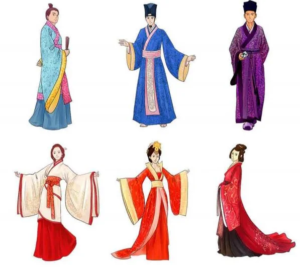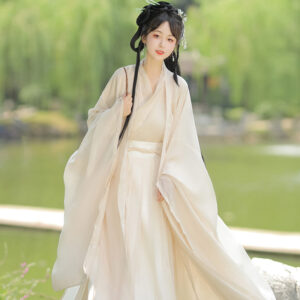
In the Song Dynasty (960-1279 AD), several fabrics were commonly used in Hanfu, each reflecting the era’s cultural values and social structures. Here are the primary fabrics associated with Song Dynasty Hanfu:

1. Silk
- Varieties: Silk was the most prestigious fabric of the time, with several types, including:
- Shu Silk: Known for its durability and rich texture, it was favored for everyday wear among the nobility.
- Song Brocade: A luxurious fabric characterized by intricate patterns, often used for ceremonial garments and indicating high status.
- Damask: Featured reversible patterns and was commonly used in formal attire.
- Cultural Significance: Silk represented wealth and refinement, making it a staple for both formal and everyday clothing.
2. Cotton
- Emergence: Cotton began to gain popularity during the Song Dynasty, valued for its comfort and ease of maintenance.
- Usage: It was primarily used for everyday garments among commoners due to its breathability and practicality.
3. Hemp
- Durability: Hemp was a robust fabric widely used among lower-class citizens. It was known for its strength and ability to withstand wear and tear.
- Common Use: Often made into heavier clothing suitable for laborers, hemp provided a practical choice for daily wear.
4. Ramie
- Lightweight and Breathable: Ramie is a plant-based fabric known for its lightweight quality, making it ideal for summer garments.
- Comfort: It became popular due to its ability to retain shape and provide comfort in warmer weather.
5. Other Fabrics
- Wool: Though less common due to China’s generally warm climate, wool was used in colder northern regions for its insulating properties.
- Bamboo and Jute: These materials occasionally appeared in clothing, particularly in areas where they were readily available.
Table: Common Fabrics in Song Dynasty Hanfu
| Fabric Type | Description |
|---|---|
| Silk | Luxurious material; includes varieties like Shu silk and Song brocade; symbolizes status |
| Cotton | Comfortable and easy to maintain; became popular for everyday wear |
| Hemp | Durable fabric; commonly used by lower-class citizens for work clothes |
| Ramie | Lightweight and breathable; ideal for summer garments |
| Wool | Used primarily in colder regions; appreciated for warmth |
| Bamboo/Jute | Occasionally used; bamboo has antibacterial properties, while jute is coarser |
The use of these fabrics not only highlights the technological advancements of the time but also reflects the diverse social strata within Song society. Each material played a significant role in daily life, symbolizing the resilience and richness of traditional Chinese culture.
Share this post
Facebook
Twitter
LinkedIn
Pinterest
Recent Posts


What were the key features of Hanfu during the Tang Dynasty?
October 24, 2024

How did Hanfu styles vary during different Chinese dynasties?
October 24, 2024

What accessories are typically worn with Hanfu?
October 24, 2024

How do you choose the right Hanfu for different seasons?
October 24, 2024

Newsletter
Subscribe for our monthly newsletter to stay updated
Popular Categories
Related Post
Sed aliquam, tortor et sodales malesuada, lorem leo luctus tellus, quis interdum eros nibh in nunc. Cras dignissim malesuada, lorem leo luctus

What are the winter hanfu called?
October 24, 2024

What were the key features of Hanfu during the Tang Dynasty?
October 24, 2024

How did Hanfu styles vary during different Chinese dynasties?
October 24, 2024

What accessories are typically worn with Hanfu?
October 24, 2024

